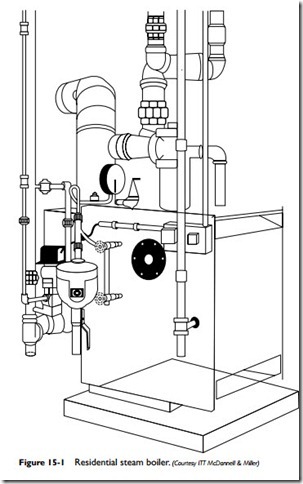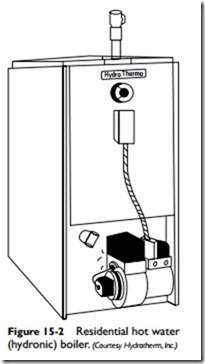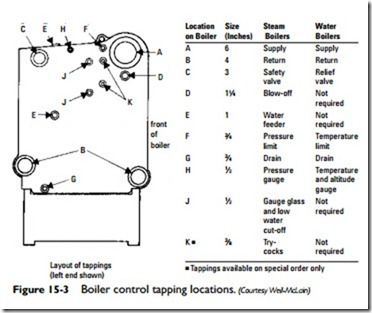Boilers are used to supply steam or hot water for heating, processing, or power purposes. This chapter is primarily concerned with a description of the low-pressure steam and hot-water (hydronic) space heating boilers used in the heating systems of residences and small buildings (Figures 15-1 and 15-2).
The basic construction of both low-pressure steam and hot- water space heating boilers fired by fossil fuels consists of (1) an insulated steel jacket enclosing a lower chamber in which the combustion process takes place; and (2) an upper chamber containing cast-iron sections or steel tubes in which water is heated or converted to steam for circulation through the pipes of the heating system.
Steam and Hot Water Boiler Similarities and Differences
Steam and hot-water (hydronic) space heating boilers are very similar physically, but there are some important differences.
• Steam boilers operate only about three-fourths full of water, whereas hot-water boilers operate completely filled with water.
• Steam boilers in residential steam heating systems operate at 2 psi pressure or slightly more, whereas residential hot- water boilers operate at approximately six times that pressure.
• Steam boilers are equipped with a low-water cutoff device to protect the appliance from burning out if it should run out of water. Only large hot-water space heating boilers with a capacity exceeding 400,000 Btu/h are presently required by code to be equipped with low- water cutoffs. (Note: Many HVAC contractors who install the smaller residential hot-water boilers strongly recommend the addition of a low-water cutoff device to these appliances to prevent burnout if the boiler loses its water.)
• Steam boilers require makeup feed to replace water lost through evaporation and the production of steam during normal opera- tion. Hot-water boilers can operate with little or no need for makeup water under the same normal operating conditions.
The design and construction of the lower chamber depends upon the type of fuel used to fire the boiler. It serves as a combustion chamber for coal-fired and oil-fired boilers and as a compartment for housing the gas burner assembly on gas-fired boilers. These gas burner assemblies are commonly designed for easy removal so that they can be periodically cleaned or serviced.
Oil burners are externally mounted with the burner nozzle
extending into the combustion chamber. This is also true of gas con- version burners. Gas burner assemblies, on the other hand, are located inside the lower chamber of the boiler.
The cast-iron sections or steel tubes in the upper chamber of the boiler contain water that circulates through the pipes in the heating system in the form of either steam or hot water. The heat from the combustion process in the lower chamber of the boiler is transferred through the metal surface of the cast-iron sections or steel tubes to the water contained in them, causing a rise in temperature. The amount of water contained in these passages is one of the ways in which steam boilers and hot-water space heating boilers are distinguished from one another. In hot-water space heating boilers these passages are completely filled with water; whereas in low- pressure steam boilers only the lower two-thirds are filled. In steam boilers the water is heated very rapidly, causing steam to form in the upper one-third. The steam, under pressure, rises through the supply pipes connected to the top section of the boiler.
A boiler jacket contains a number of different openings for pipe connections and the mounting of accessories. The number and type of openings on a specific boiler jacket depends upon the type of boiler (i.e., steam or hot water). Among the different openings to be found on a boiler jacket are the flue connection, water feed (supply) connection, inspection and cleanout tapping, blowdown tapping, relief valve tapping, control tapping, drain tapping, expansion tank tapping, and return tapping. There are also gas and oil burner connections. Figure 15-3 illustrates the arrangement of control tap- pings in a Weil-McLain oil-fired boiler.
Most (but not all) of the controls on low-pressure steam and hot-water space heating boilers fired by the same fuel are similar in design and function, but there are exceptions. For example, a few boiler controls and fittings are designed to be specifically used on steam boilers; others are found only on hot-water space heating boilers. The various boiler controls and fittings are described in the appropriate sections of this chapter.


